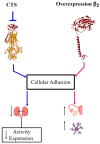Molecular Basis of Na, K-ATPase Regulation of Diseases: Hormone and FXYD2 Interactions
- PMID: 39769162
- PMCID: PMC11678576
- DOI: 10.3390/ijms252413398
Molecular Basis of Na, K-ATPase Regulation of Diseases: Hormone and FXYD2 Interactions
Abstract
The Na, K-ATPase generates an asymmetric ion gradient that supports multiple cellular functions, including the control of cellular volume, neuronal excitability, secondary ionic transport, and the movement of molecules like amino acids and glucose. The intracellular and extracellular levels of Na+ and K+ ions are the classical local regulators of the enzyme's activity. Additionally, the regulation of Na, K-ATPase is a complex process that occurs at multiple levels, encompassing its total cellular content, subcellular distribution, and intrinsic activity. In this context, the enzyme serves as a regulatory target for hormones, either through direct actions or via signaling cascades triggered by hormone receptors. Notably, FXYDs small transmembrane proteins regulators of Na, K-ATPase serve as intermediaries linking hormonal signaling to enzymatic regulation at various levels. Specifically, members of the FXYD family, particularly FXYD1 and FXYD2, are that undergo phosphorylation by kinases activated through hormone receptor signaling, which subsequently influences their modulation of Na, K-ATPase activity. This review describes the effects of FXYD2, cardiotonic steroid signaling, and hormones such as angiotensin II, dopamine, insulin, and catecholamines on the regulation of Na, K-ATPase. Furthermore, this review highlights the implications of Na, K-ATPase in diseases such as hypertension, renal hypomagnesemia, and cancer.
Keywords: FXYD2; Na, K–ATPase; cancer; diseases; hormonal regulation; hypertension; ion transport; protein kinases; receptors; renal hypomagnesemia; signal transduction.
Conflict of interest statement
The authors declare no conflicts of interest.
Figures







References
Publication types
MeSH terms
Substances
LinkOut - more resources
Full Text Sources

